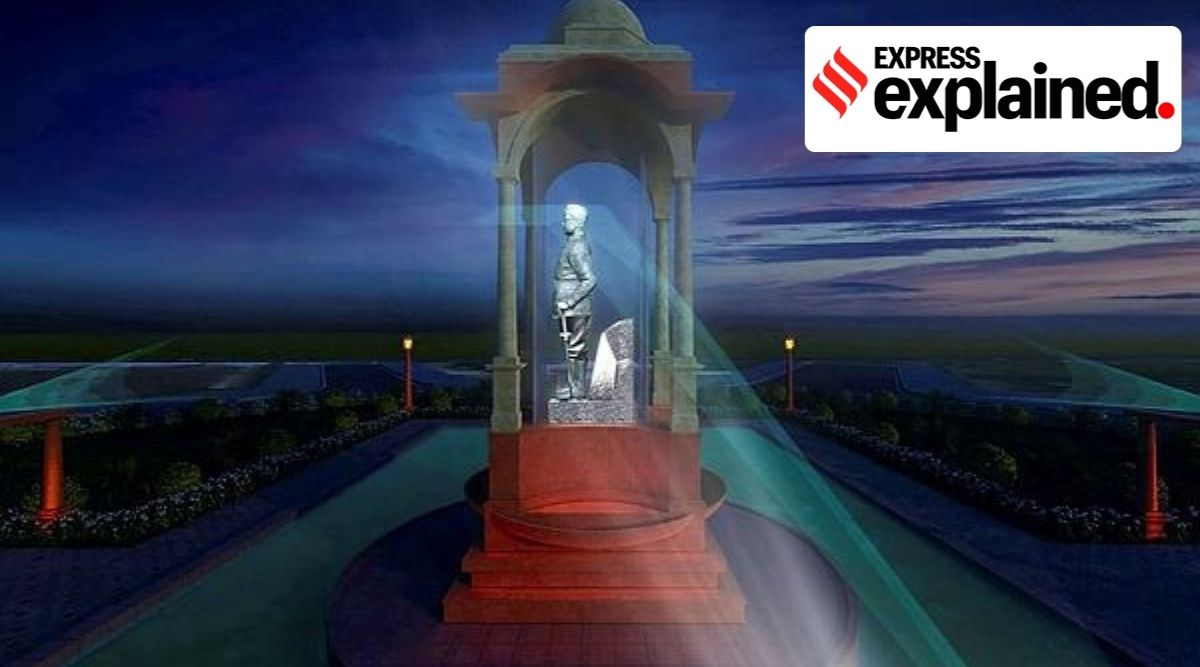
A grand statue of Subhas Chandra Bose will be installed under the grand canopy at India Gate, near which the Amar Jawan Jyoti flickered for 50 years until Friday afternoon. Until the installation of the actual statue is completed, a hologram of Bose will be projected at the site of the statue, Prime Minister Narendra Modi announced on Friday.
So, this Republic Day, the celebrations will be held at a different-looking Central Vista Avenue.
The site & the statue
India Gate was built in the 1920s as a World War I memorial on Kingsway, now called Rajpath. Designed by Sir Edwin Lutyens, the main architect of Delhi, the gate evokes the architectural style of triumphal arches around the world. About 150 m east, at a junction of six roads, is the 73-foot canopy, inspired by a sixth-century pavilion from Mahabalipuram. The canopy was added in 1936 as a tribute to the recently deceased Emperor of India, King George V, and housed his 50-foot marble statue, erected by Charles Sargeant Jagger, in his coronation robes and the Imperial State Crown.
On the night of January 3, 1943, some Quit India movement activists scaled the statue, smashed its nose and draped it with a large black cloth inscribed ‘Death to the Tyrant’. After Independence, there was widespread opposition to the statue’s central location, but it stood at the site for another two decades, until it was moved to Coronation Park in 1968. Coronation Park was the venue of the Delhi Durbar in 1877 to mark the proclamation of Queen Victoria as the Empress of India, in 1903 to mark the accession of King Edward VII, and in 1911 when King George V became Emperor of India.
There have been deliberations during successive governments of installing a Mahatma Gandhi statue where King George V’s statue stood, or one of Jawaharlal Nehru or even of Indira Gandhi post-1984. Historians, however, insisted it should remain empty as a reminder of the country’s past. So, for more than five decades, the canopy remained empty, earning the name ‘Empty Canopy’.
Why Bose
Last week, the government announced that from this year onwards, Republic Day celebrations will start on January 23 rather than the usual January 24, to mark Bose’s 125th birth anniversary. When the PM inaugurates the hologram that day, a special programme will honour the winners of Netaji Subhas Chandra Bose Apada Prabandhan Award for contributions in disaster management. The government had earlier announced that Bose’s birth anniversary would be celebrated as Parakram Divas. Museums dedicated to Bose have been set up at the Red Fort and Victoria Memorial in Kolkata. During its first term, the Modi government had also declassified several files related to Bose’s life and times, through the National Archives of India. But there was a realisation that Bose is perhaps the only national leader who doesn’t have a statue or memorial dedicated to him in the capital.
The hologram
A hologram is a three-dimensional projection that can be seen without using any special equipment, and appears to move and shift realistically as the viewer walks around it. The dimensions of the hologram statue of Bose will be the same as the actual one being sculpted. There is no clarity yet on whether the hologram will beam all day or only on special occasions. Officials say it is likely to be beamed for the duration of the Republic Day celebrations until January 28.
Newsletter | Click to get the day’s best explainers in your inbox
https://indianexpress.com/article/explained/explained-why-netajis-statue-is-being-installed-at-india-gate-7735482/
2022-01-23 09:27:14Z
1253449015
Bagikan Berita Ini

















0 Response to "Explained: Delhi’s first Netaji statue, where George V once stood - The Indian Express"
Post a Comment